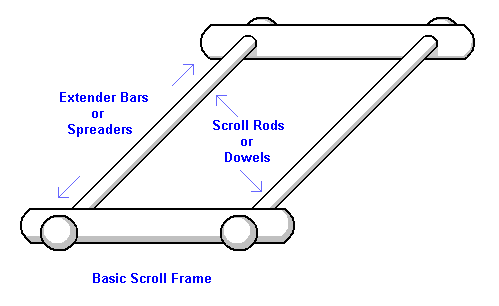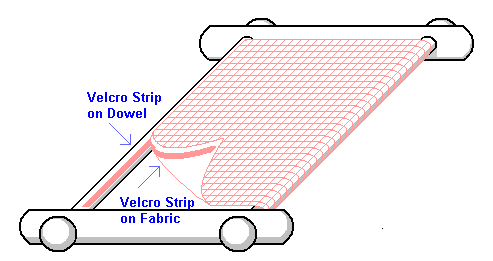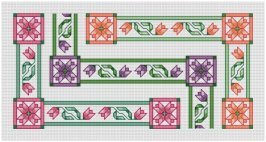Choosing a Scroll Frame
for Cross Stitch
If you're trying to envision how a scroll frame works, it helps to imagine a long-bearded man reading from a scroll in one of those classic movies. It really is just the same. Just substitute fabric for papyrus.

When comparing frames, the primary measurement refers to the length of the dowels, usually ranging from 6" to 22". Read further in the product description to determine the length of the extenders, commonly 6" and 8".
The only difference between those old scrolls and a cross stitch scroll is that parallel slats hold the rods at a fixed distance apart. The fabric stretched between the rods keeps your work area taut for stitching.
Click here to share YOUR experience working with scroll frames!
Click here for Scroll Frame Reviews from Visitors.
Purpose of a Scroll Frame
A frame keeps your fabric taut as you cross stitch.
Characteristics
- a frame keeps a whole piece of fabric taut throughout the entire stitching process, whereas an embroidery hoop is often smaller and keeps only a section of your fabric taut, causing you to move it from place to place
- fabric is left attached to the frame until the whole design is stitched
- two parallel sides of a wooden frame are constructed of two flattened strips of wood (often referred to as extenders or spreaders), with two round scrolling dowels or rods making up the other sides.
- if your fabric is longer than the frame, the fabric can be rolled from side to side as you stitch the design
- they vary in the way you attach fabric to the rods
|
- many have knobs at the ends of the rods for advancing the fabric to another area for stitching
- sold in a variety of sizes
- can be purchased in a multi-pack containing a couple of sizes of bars/spreaders (the fixed sides) and several sets of the dowels/scroll rods in varying lengths
- are hand-held or can be attached to a variety of stands for hands-free stitching such as the Z Lap Frame with Clamp shown here
Some Advantages
- keeps fabric taut as you cross stitch
- as with hoops, some stitchers feel that frames help maintain consistent stitch tension and appearance
- can be attached to floor stands (like the one below), table stands, lap stands, fanny stands and clamp stands
- when attached to a stand, it leaves both hands free, allowing those who use the stab method to keep a hand above and the other below the fabric, which increases stitching speed
- does not leave rings or marks on fabric like hoops can
- you can buy kits that allow you to combine individual components, making frames in several different sizes
Things to Consider Before Buying
- unless attached to a stand, either one hand must hold the scroll frame while the other hand stitches, or you must prop up the frame
- unless attached to a stand, larger frames are heavy to support after prolonged stitching
- because they're larger, frames can be less portable than hoops
- stitchers have a wide variety of opinions on which frame styles hold the fabric tension best; you may have to try a few to find the rod mechanism you prefer
- if you use the adhesive velcro(TM) technique to attach your project to the rods, plan on cutting off and discarding these fabric ends when finished
- scroll rods or dowels can warp over time
- frames are more expensive than hoops
- frames are less flexible than hoops, or if you work on projects in a wide variety of sizes, you may need to buy several frames or purchase kits that allow you to build frames in several different sizes
- should loosen the tension whenever not stitching

Scroll frame with Velcro(TM) strips added to both the dowels and the edges of the cross stitch fabric. Be sure to use enough fabric to allow for cutting off the strips and discarding them when finished, as the adhesive residue is difficult (and sometimes damagaing) to remove.
Price
- When looking up prices, the size (as in "Oak Scroll Frame, 12") refers to the length of the dowel (the number of inches between the extender bars).
- The written description may then also include the size of the extenders. A single 6" scroll frame is around $18 (can be found on sale for around $13). A 22" frame is about $22.
- A frame kit allows you to mix and match extenders and dowels. One including 6", 12" and 18" scroll rods (with fabric attached for basting) and 6" and 8" extender bars is $45, seen on sale for around $32.
- Scroll rod pairs can be purchased alone for use with your existing extenders. (Make sure they are compatible.)
My Recommendations
- Trying out frames is similar to trying out hoops. If you are new to cross stitch, select two small trial projects. Stitch the first without a frame or hoop. On the second project, start stitching with a hoop (an inexpensive way to get the feel for stitching while your fabric is taut).
- Halfway through the project, switch to a scroll frame. Either borrow a friend's frame or purchase a small, basic model.
- Then, if you prefer having your fabric held, look online and read product reviews for specific frames. Other stitchers' experiences can help you decide which models to start with. Nothing, however, can substitute for personally working with these items.
- If you end up with frames you dislike using, you can use them to display your finished projects.
- Before investing in several frames, think ahead. It is likely that you will want to use some sort of stand, so make sure the frames you buy are compatible with the different stand varieties available. Also consider portability -- will you do most of your stitching at home, or will you carry it with you?
- Remember to loosen the tension on your project when you are not stitching. This preserves both your stitching and the frame.
You may find that scroll frames are just what you need to make cross stitch easier and more enjoyable. If it's just a bit "too much," consider trying an embroidery hoop instead. Each has its advantages and true believers. You won't know which one you like, or even if you'll like it, until you try.
Do you love your scroll frame...
...or hate it?
Write about it here!
Whether you've been using a scroll frame for ages or just started, you are sure to have an opinion about it. Which type or brand is it? Do you use a stand? Would you recommend it to another stitcher?
Share your opinion here! Your review will help other visitors.
Read Scroll Frame Reviews
from Other Visitors
Click below to see reviews of scroll frames written by visitors to this page.
Fabric Mounts 




I want to ditch my old split rail frames and stand. I have read about a new product called, Fabric Mounts. It is supposed to keep material taut and aligned …
Hate My Split Rail Scroll Frame! 




The frames simply do not keep the fabric tight enough.
The Millennium scroll frame from NeedleNeeds looks like the perfect solution, but I have't …
My Split Rail Scroll Frame-Took time to grow on me...but.... 




...After I finally learned how to use my split rail scroll frame right and 'got used to it' - things went much easier for me. I purchased it because it …
Hate My Wood Split Rail Frame 




When I purchased this split rail scroll frame, it claimed that all you needed to do was insert your fabric and start stitching.
Not so.
When you …
Not Enough Information Not rated yet
You left a very important piece of information out if the instructions on setting up the frame and securing the canvas: How to keep the sides tight.
Love All My Scroll Frames... Not rated yet
Love all my scroll frames, except the one that has to have the cloth attached with a push pin or staples.
After seeing the velcro scroll frame, I may …
I Love My Scroll Frame! Not rated yet
I used hoops in my early days as a counted cross stitcher. My husband and I loved the finished work, but hated the hoop mark that was left behind. Nothing …
Split Scroll Frame on Stand Not rated yet
I am going to be sewing a LARGE Oak Ally. The only problems I can see is the stand only scrolls Vertically.
What can I do If my fabric is way bigger …
Ratchet scroll frame - Not rated yet
Love the concept - once you get your project on there and taut, you roll the top or bottom and the other rolls with it.
I've struggled from day one …
Home › Cross Stitch Supplies › Scroll Frame
